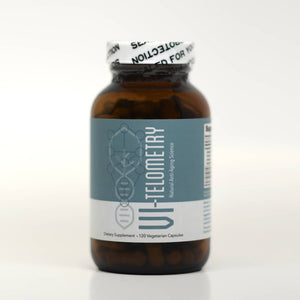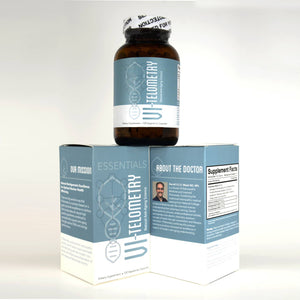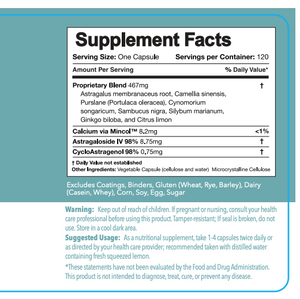Your Cart is Empty
Anti-Aging Supplement backed by science



As a nutritional supplement, take 1-4 capsules 2 times daily. Take with water and fresh squeezed lemon.
Keep out of reach of children. If pregnant or nursing, consult your health care professional before using this product. Tamper resistant. If seal is broken, do not use. Store in a cool, dark area.
Astragalus (Astragalus membranaceus) has been a foundational herb in Chinese Medicine for hundreds of years for its suggested properties to affect the liver, adrenal, and immune systems. Astragalus research in relation to telomerase activity is numerous, with the isolated compounds CycloAstragenol and Astragaloside IV becoming staple ingredients in many online and professional nutritional telomerase products, including VI-Telometry.
Camellia (Camellia sinensis) has been cultivated in India, China and Japan for hundreds of centuries and has been suggested to support digestion, metabolism, cardiovascular health, mental stimulation. It has some of the highest antioxidant activity of any plant known to mankind. The antioxidant activity of green tea is attributed to polyphenols called catechins; epigallocatechin (EGC), epicatechin (EC), epigallocatechingallate (EGCG) and epicatecatechingallate (ECG). Much of the telomerase research with green tea reflects a suggested ability of various catechins to selectively inhibit telomerase activity in various cancer cell lines, thus shortening telomeres and inducing apoptosis (cell death) in those cancer cells.
Purslane (Portulaca oleracea), considered a common weed by many, is a succulent annual plant that grows in many countries due to its nature to thrive in poor soil. Purslane leaves top the lists of plants rich in omega-3 fatty acids and vitamin E, as well as being a good source of beta carotene, vitamin C, magnesium, riboflavin, potassium and phosphorus. Also present are two types of betalain alkaloid pigments, betacyanins and betazanthis, which both have been found to be potent antioxidants along with being found to have anti-mutagenic properties in laboratory studies.
Sambucus (Sambucus nigra) has a long history of use in traditional cultures to support immune function and has been used by many Native American tribes as a tonic medicine to promote health and vitality. Research studies show flavonoid compounds found in Sambucus to have immune modulating and antioxidant properties. The inclusion of Sambucus in VI-Telometry is based on these suggested protective properties.
Ginkgo (Ginkgo biloba) is the oldest surviving tree species and has been referred to as “the living fossil.” With over 400 scientific research publications, there are many well established uses of Ginkgo, especially to support brain and cognitive function. Brain support is based on many suggested actions of Ginkgo, including antioxidant activity, optimizing blood flow, and neuroprotective actions, but some believe the combined effects are probably greater than that of an individual mechanism and perhaps result in synergistic effects. Along with Ginkgo research suggesting an increased telomerase activity, its added circulatory and brain supportive properties make it an obvious choice for the VI-Telometry product.
Milk Thistle (Silybum marianum) has an extensive history of use with 1st century writers reporting its liver supporting properties. Numerous Milk Thistle studies explore its constituents called silymarins, and suggest antioxidant protection and liver supportive properties, particularly protection from free radicals and other toxins that normally enter into the liver and cause damage. VI-Telometry inclusion of Milk Thistle is due to the importance of liver health and protection from a naturopathic perspective, along with telomerase studies suggestive of upregulation by Milk Thistle.
Cynomorium (Cynomorium songaricum) has long been used in Chinese Medicine as a yang tonic for sexual potency and fatigue. As a renowned Chinese herb particularly for male health, many people regard this yang tonic as “the true elixir of youth." Modern pharmacological actions of cynomorium root suggest ability to enhance plasma testosterone levels, lower blood pressure, promote saliva secretion, and increase the synthesis rate of intracellular DNA and RNA. The low levels of cynomorium in VI-Telometry are included for these suggested effects, along with increasing telomerase activity in mice.
Lemon (Citrus limon) was originally from India and reportedly was brought to America by Columbus on his second voyage. Some of the historical suggested health benefits of lemon include topical antimicrobial activity, to decrease kidney stone formation, treat scurvy, colds/flu, and supply vitamin C, improve circulation and blood pressure, assist in systemic alkalinization, and bio-electrically support the liver to generate energy and provide amino acids to help in enzyme production. Lemons inclusion in VI-Telometry is based on bio-electric principles to generate anionic energy and promote alkalinization, which theoretically improves energy utilization and performance.
Min-Col-Forte is made from a raw material source known as Calphos, which is soft rock phosphate. In 1976 Jim Daily Jr. and Mary Jo Daily began studying RBTI with Dr. Carey Reams and experimented to create a clean fine particulate Calphos product to serve as a mineral colloid to theoretically improve nutritional availability. The inclusion of mineral colloids into VI-Telometry is based on the bio-electric requirement of minerals to generate energy, which is believed to be required for all life to sustain itself and restore.